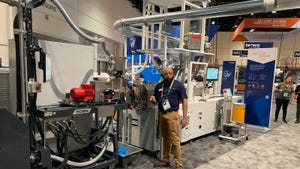Instant handheld analysis of plastic film substrate surfaces
The Surface Analyst works in two seconds to detect poorly prepared packaging substrate surfaces that can result in printing or sealing failure.
May 21, 2018

An innovative handheld solution for inspecting flexible packaging film can help reduce waste, rework, and recalls that result when poorly prepared substrate surfaces lead to printing or sealing failure. Developed and manufactured by BTG Labs (St. Bernard, OH) the Surface Analyst measures the surface energy level of a film surface and determines if it is properly prepared for adhesion in two seconds. It is a safe, simple, accurate and nondestructive inspection instrument for manufacturers of flexible packaging, where critical film surface requirements can mean the difference between success and failure. 
Ensuring the surface condition and consistency of a film is a vital component for guaranteeing success when printing or sealing a flexible package or pouch, or when printing a film label.
Dyne pens and inks have been the industry standard for inspecting film surface tension in recent years. They are used to help film users understand what their surface energy and interfacial tension measurements look like before and after surface treatment processing. One reason for their sustained use has been that they are financially inexpensive, but in recent years companies have increasingly realized that they also have a number of critical drawbacks. One of those is that they are chemically destructive to the materials they inspect, resulting in wasted product. They are also teratogenic, meaning that they can potentially cause birth defects when used by pregnant employees.
For the companies using them, a significant practical drawback is that they produce subjective results, and those results can vary from user to user. This means those results are unrepeatable as well as unreliable. And lastly, employees using the dyne pens and inks need to be highly trained in their use, adding cost and time to their use.
The Surface Analyst can verify the effectiveness of corona and flame treatment. With a push of a button, the instrument quantifies the quality of the film surface. To acquire the measurement, the Surface Analyst uses patented ballistic deposition technology to deposit a highly purified drop of water on the surface of the film and measures the contact angle—a direct correlation to surface energy.
Typical inspection points within film and flexible packaging manufacturing include:
Monitoring incoming material from suppliers: manufacturers need to have a baseline understanding of the condition of a film’s surface prior to it entering their production process. The measurements produced by the Surface Analyst give manufacturers the ability to monitor supplier specifications;
Determining the effect of surface aging: material surfaces deteriorate over time. The Analyst determines the optimal amount of time that a surface can be kept in storage before the surface is no longer fit for adhesion;
Defining optimal surface treatment levels: the Surface Analyst gives manufacturers the ability to quantify the effectiveness of their surface treatment processes, such as flame and corona treatment. Manufacturers also use the measurements to determine the optimal level of treatment to avoid damaging the material surface from overtreatment and undertreatment;
Monitoring daily production processes: over time, processes slowly drift out of spec. The Surface Analyst is used to monitor production processes to ensure the line is working at its highest level of efficiency.
BTG Labs will be demonstrating the device during the co-located PLASTEC East, MD&M and EastPack event June 12-14 in New York City, and invites visitors to bring in samples of their own product to inspect with the Analyst in Booth #762. For more about the event, click here.
About the Author(s)
You May Also Like

